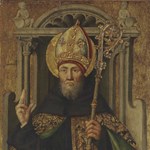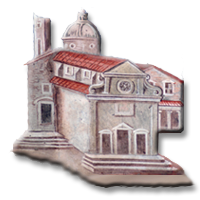This arresting image, probably originally the central component of an imposing altarpiece, shows the Church Father Saint Augustine, an early Christian theologian whose writings formed the foundation of the Augustinian order. Augustine appears in the religious vestments which accord with his title as Bishop of Hippo, including an elegant brocaded cope decorated with images of saints in fictive niches, as well as a crozier and mitre, both of which are embellished with fine pastiglia ornamentation. Seated on a fictive marble throne surmounted by playful putti, Augustine raises his hand to bless the viewer. His intently focused, stern gaze and curly, grayed beard enhance his aura of solemnity and wisdom, while the black monastic robes visible beneath his ornate mantle remind the viewer of his humility and asceticism.
Antoine de Lonhy has recently been identified as the artist formerly called the Master of the Trinity of Turin (sometimes known as the Saluces Master or the Master of Saint Anne of Turin), an anonymous, peripatetic painter named for a Trinity in the Museo Civico de Arte Antica in Turin. Several other panels, as well as frescoes, miniatures and designs for stained glass, had been associated with this monumental work before the artist's real identity was discovered by Giovanni Romano and François Avril. Recently uncovered documents show that De Lonhy probably trained in Burgundy in the 1440s, where he was exposed to the models of Jan van Eyck and Rogier van der Weyden, and was employed by some of the most important patrons of the time, including Nicolas Rolin (1376-1462), chancellor to Philip III (called Philip the Good), Duke of Burgundy, and Jean Germain, bishop of Chalon-sur-Saône from 1436-1461. In the early part of his career, De Lonhy also worked in Toulouse and Barcelona, and eventually passed through Lyons and Avignon before settling in Savoy, near the present-day border with Italy, where he illuminated a manuscript for the widow of the Duke of Savoy, Yolande de France (untraced).
The present work was first illustrated in the publication of the collection of images taken by the Florentine photographers Jacquier, when it was associated with the school of Provence or Nice (loc. cit.). It was first published in 1995 as an autograph work by Antoine de Lonhy by Giovanni Romano (loc. cit.), who was instrumental in reconstructing the artist's oeuvre. We are grateful to Till-Holger Borchert, who has confirmed the attribution of the panel based on firsthand inspection, and remarked that it is 'without doubt on the top row of authentic panels by [the] master' (private communication, 28 August 2013).
Fonte: www.christies.com



